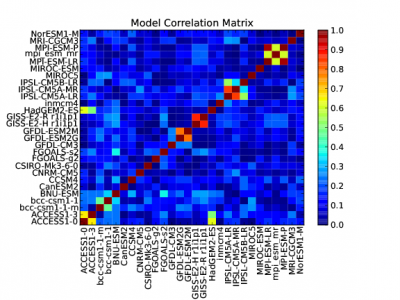Can Data Mining Help Constrain Climate Sensitivity?
Equilibrium climate sensitivity (ECS, the amount of global-averaged equilibrium surface warming resulting from a doubling of atmospheric CO2) is one of our primary measures of global warming risk. Recently, several studies have estimated ECS by using quantities in the current climate which are skillful predictors of ECS yet can be constrained by observations. In this study we automate the search for observable predictors of ECS using data from Phase 5 of the Coupled Model Intercomparison Project (CMIP5). We search through more than 40,000 aspects of current climate and identify those best correlated with ECS. A new technique is developed to test the statistical significance of these correlations accounting for relationships across models and predictors.
Our significance test indicates that none of the relationships we tested pass a significance test at the 95% level. We conclude that relationships between ECS and current-climate variables posited by recent studies may not be robust. We conclude that data mining the CMIP archive is best used as a way to identify potential relationships which are then validated or discarded using physically-based hypothesis testing. We note that the strongest predictors of ECS are related to the Southern Ocean and suggest that this area may be the most fruitful place to search for constrainable predictors of ECS.
Thanks go to modeling groups and the Program for Climate Model Diagnosis and Intercomparison (PCMDI), the World Climate Research Program’s Working Group on Coupled Modeling, and the DOE Office of Science for their roles in making available the CMIP5 multi-model dataset. C. S. Bretherton is funded by NASA grant NNX09AH73G. B. M. Sanderson is supported by the Office of Science, Biological and Environmental Research, U.S. Department of Energy, Cooperative Agreement No. DE-FC02-97ER62402 and the National Center for Atmospheric Research which is sponsored by the National Science Foundation. All other authors are supported by DOE’s Regional and Global Climate Modeling Program.

